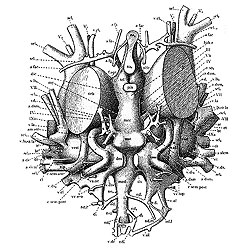Taxonomy
Cephalaspis lyelli was the first species of Osteostracean discovered. Osteostraceans were a diverse group of jawless fish ranging in time from the middle Silurian to the late Devonian period.
There are only two groups of jawless fishes alive today:
- the hagfish, which are mostly scavengers living in the deep sea
- the lampreys, many of which live in freshwater and feed on the blood of other fishes

A diagram of the brain nerves and blood vessels of Cephalaspis hoeli, from Stensiö, 1927
They do not have a bony skeleton, and their fossil record is poor.
By contrast, Cephalaspis and its relatives were bottom-dwelling animals that sifted mud for organic matter, and were protected by bony scales and a strong head-shield.
Fossils of cephalaspids are found in Europe and North America, and two related groups have been found in Australia and China.
The skull and internal morphology of Cephalaspis lyelli and its relatives is very well known thanks to the work of the Swedish palaeontologist Erik Stensiö.
Stensiö sectioned and photographed specimens, and created wax models, revealing intricate details of internal anatomy, such as the position of the nerves, blood vessels and the structure of the brain, but destroying the specimen in the process.
Today, using CT scanning we can gather this information without damaging the specimens.
Since 1835, over a hundred different species have been referred to the genus Cephalaspis. But recent work indicates that only three other species Cephalaspis producta, Cephalaspis cradleyensis, and Cephalaspis sollasi should be included in this genus.
